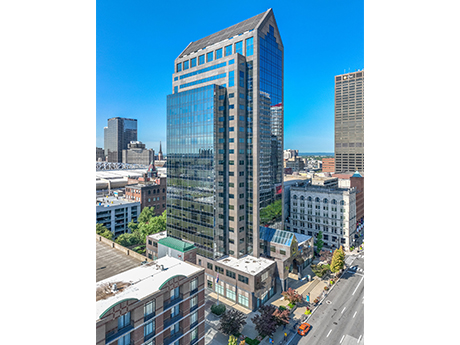The Louisville office market is at an interesting crossroads, to say the least. Historically, the sector has always skewed toward the suburban submarkets as east Jefferson County has been the go-to area for companies looking for office space.
Over the past few years, the shift to the suburbs has become more pronounced than ever as Louisville’s office market experiences a dramatic contrast between the current state of the overall office market in the suburbs versus the central business district (CBD). In the suburban markets, the premier office buildings are experiencing low vacancy rates and record-setting growth in rental rates.

On the opposite side, the CBD continues to struggle with increases in vacancy rates, which is expected to increase in the coming months. This trend reflects overall national office trends as companies focus on new, highly amenitized spaces to offer their employees.
Suburban Louisville
The suburban office market in Louisville has demonstrated reliable stability over the past four years. As of second-quarter 2024, the vacancy rate for Class A spaces stood at 12.7 percent, while Class B spaces recorded a higher rate of 17.2 percent.
The suburban market has seen limited new construction deliveries thus far in 2024. The most notable addition has been The West, nestled in the burgeoning Old Henry Road corridor. This 72,000-square-foot building has already secured a lease with Dan-O Seasoning’s for the first floor and is experiencing substantial leasing activity. NTS Development has partnered with Heaven Hill Distillery for its new 48,000-square-foot headquarters within the Shelbyhurst Office Campus, which is scheduled to be completed in 2025.
However, there are some concerns in the suburban market, particularly for owners of Class B office space leased to tenants over 25,000 square feet. There are currently five buildings in the suburban market with over 50,000 square feet of contiguous space available. This is due to larger tenants evaluating their needs for space, and many are opting to downsize and relocate to the Class A properties in smaller footprints.
With many tenants gravitating toward the highly amenitized buildings, owners of Class B properties are having to get creative on their leasing strategies. Many landlords are taking their least attractive spaces and creating speculative suites that are ready to be leased to tenants immediately.
Last year, we witnessed several office buildings over 50,000 square feet sell to owner/users. However, 2024 has seen a reduction in the number of sales transactions as there have not been any sales of buildings over 50,000 square feet this year.
Downtown Louisville
On the other side, Louisville’s downtown continues to struggle as many of the largest employers in the submarket reduce their office footprints. Louisville’s Class A office space in the CBD ended second-quarter 2024 with a record high vacancy rate of 26.1 percent. This is largely due to “right sizing” by many corporations that are navigating the post-pandemic shift to hybrid working. These statistics don’t encompass the recent announcements made by Humana and LG&E, which are both huge office users in the Louisville CBD that will both be vacating their respective offices in 2025. Humana will downsize into its Waterside building on Main Street, while LG&E will relocate employees to its offices on Broadway and its new suburban building in Eastpoint Business Park.
However, there are silver linings for the CBD: the Army Corps of Engineers recently announced its plan to backfill 150,000 square feet of space that will be left by LG&E at 220 E. Main St. The large increase in vacancy downtown will present similar opportunities for tenants to backfill Class A space at a significant discount.
Due to rise in vacancy, landlords are offering concession packages to attract new tenants. The rise in construction costs has also forced landlords to increase their tenant improvement (TI) allowances. As a result of the increased allowances, we haven’t seen rental rates fall as far as we would have anticipated. In 2019, the asking rental rate for Class A space downtown was $19.30 per square foot while in 2024, those asking rates have only slightly decreased to $18.86 per square foot.
In addition to the leasing incentives offered by landlords, the City of Louisville established its own incentive package to attract tenants downtown. The city was offering tenants with space larger than 5,000 square feet additional funds to contribute to TIs within their spaces, as well as discounts on parking for the first five years of their leases. This incentive was only offered for 12 months, but due to the interest this incentive generated, it’s fair to anticipate the city will develop a similar package to continue to drive growth in downtown Louisville.
Another bright spot just outside of the CBD is the vibrant NULU district, which remains a desirable location for businesses seeking high-quality space. Weyland Ventures’ NULU Yards, a mixed-use development, is going to fill a large demand for large block office space within the city’s most popular neighborhood. There are several other planned developments in NULU that will offer office space for companies that want to be a part of the growth of this neighborhood.
Outlook
Overall, Louisville’s office market is experiencing many of the same trends that are prevalent across the country. Our market is resilient, and Louisville has proved time and time again it’s a place where companies can successfully establish a footprint and do business.
— By Michael Somervell, First Vice President, CBRE. This article was originally published in the September 2024 issue of Southeast Real Estate Business.


